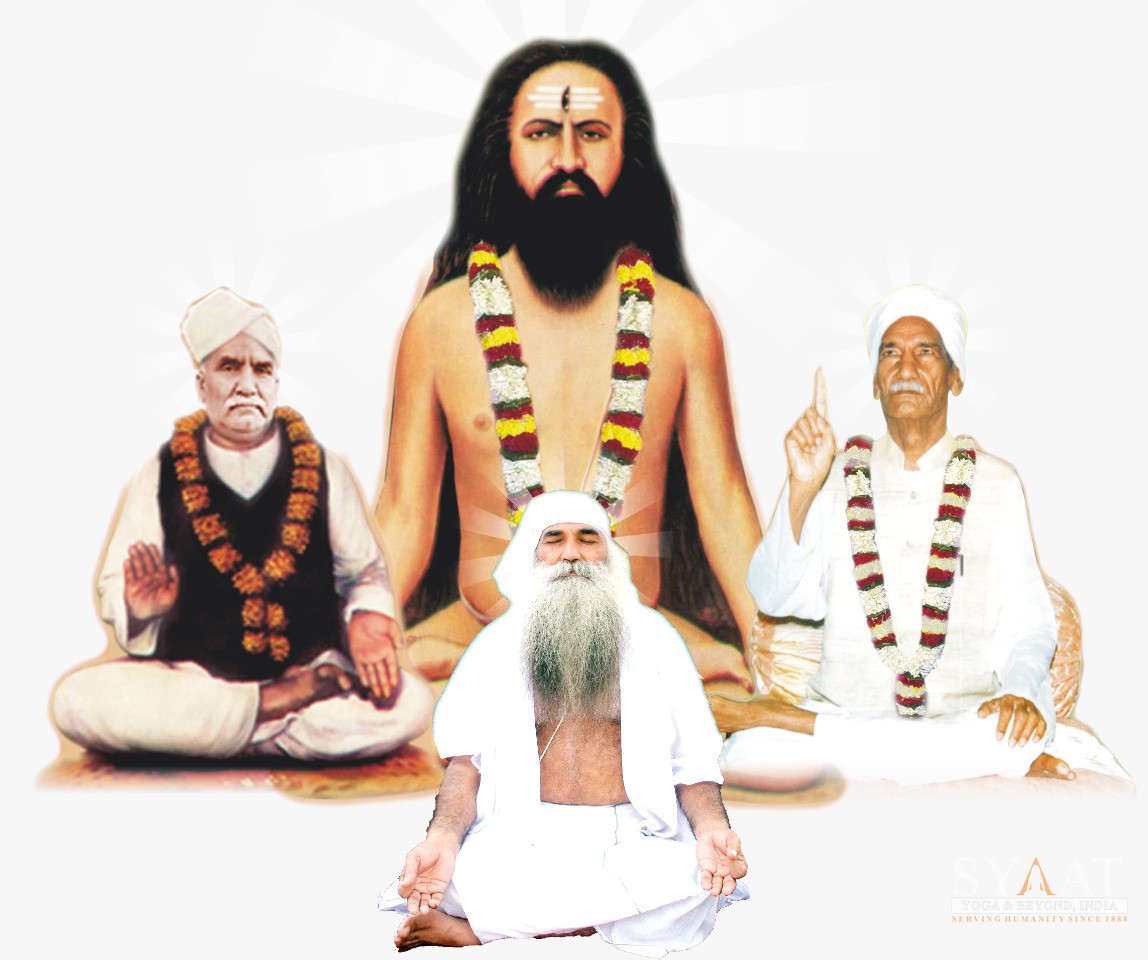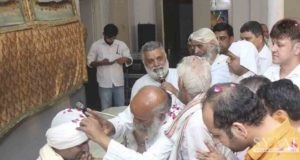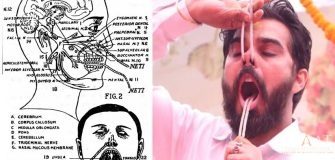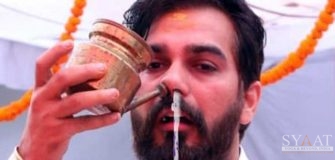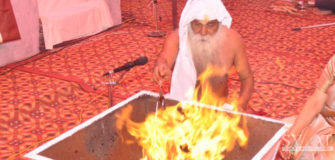Pratyahar : The Beginning of The Second Half
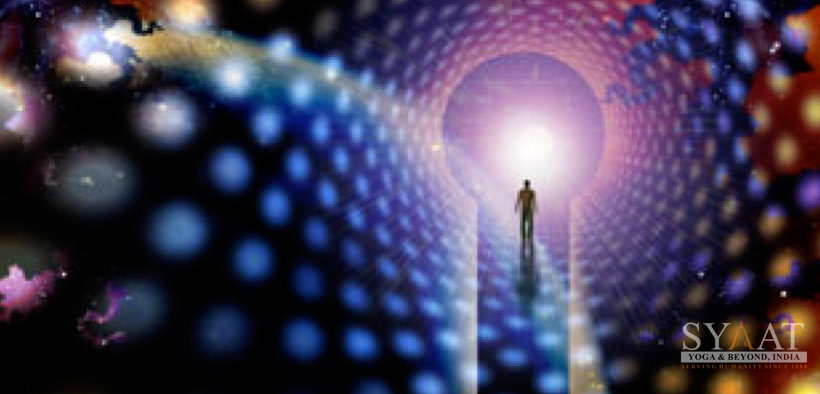
Pratyahar as Sage Patanjali defines it is abstention of mind such that the senses do not reach their objects. Oh, how powerful is the thrill of love and lust. The mind madly runs after the objects that serve as stimuli and creates and creates the feelings. The attractions and allurements keep it riveted on them and thus we become the slaves of tempting objects. whereas we should be the masters and it should be at our will to fix the mind on any object or idea. A controlled mind will never let its subject the individual indulge in wrong and foolish deeds and feel miserable. The senses instantly retreat when mind is withdrawn from their objects. This is ‘Pratyahar’.
Our mind is like the vertex of a triangle with sense organs and sense objects as the base points. As a green signal is flashed from the mind the sense organs make a dash towards the sense objects and the triangle of human bondage gets completed. A deep sense of retreat accompanied with restraint of mind together with a developed will power can only save the human being from the cat astrophic acts of imitating senses.
Pratyahar teaches us to make best use of our power of imagination. Faculty of day dreaming involves imaginary objects but the disappointments it brings are real. We feel miserable. So give it a little twist, cling to the thought of God derive divine contentment and be happy.
Wisdom builds the edifice of meditation on the strong foundation of Pratyahar. It reverses the movements of mind, the very cause of human bondage and weakness. Pratyahar has a controlling and calming effect on thoughts and emotions.
“Yogashchitta Vitti Nirodhah”
The very definition of Yoga gets realised here in Pratyahar, where the whirlpool of thought waves or ‘vrittis’ that keep flooding the mind are not only stopped and controlled but are also channelised in the right direction just as the flood water stored in a dam is regulated through canals for useful irrigation purposes.
Practice of ‘Pratyahar’ alone does a noble service to the mankind. It not only cuts and controls the thought waves but also relives the common man of unnecessary emotional stress, worry, fear, frustration and insecurity which may cause diverse diseases like peptic ulcer, coronary thrombosis, high blood pressure, tuberculosis, pneumonia, appendicitis, diabetes, asthma and schizophrenia. In the western world almost half of the patients suffer from minds turbulence and emotionally induced complaints. Pratyahar has the power of stilling the mind and holding the flame of passions steady.
Leaving the external world apart, Pratyahar serves as entrance in realizing the internal world of consciousness. The ever agitated senses and the mind after control are put to task for walking the consciousness. ‘Vishnu Puran’ confirms that no one, not even a yogi can achieve the aim of yoga without controlling the senses. Mad rush of mind and mental modifications can only be restrained by patience and renunciation through ‘abhyas’ and ‘vairagya’. Pratyahar silences both positive and negative ‘vritts’ and stills the ‘sankalpa’ and ‘vikalpa’ to help the mind shine in its own pristine glory in the glow of pure consciousness of ‘Atman’ itself.
Literally the word ‘Pratyahar’ means pulling back, the withdrawl, getting away from ‘maya’ the illusory world-the deceptive world of sensual pleasures as it is non-existent in the Absolute Realm of the Supreme Lord.
When all the senses get detached from their objects ‘Pratyahar’ gets accomplished and one can fully comprehend the mystery of mind. When senses are not attached to actions they usually undertake, the mind becomes devoid of the spirit of ego. Wisdom has a free play. The whole business of live senses calms down. The mind enters the realm of peace, the ‘chatta’ the subconscious mind. This is the state of Pratyahar and its duration can be rolonged at will to sustain the effect through regular practice and attaining perfection in ‘Ashtang Yoga’.
Withdrawl of racing mind from outside objects and tethering it inside in the self is ‘Pratyahar’. It generates patience. In due course of time this withdrawl of senses will be at ‘will’. They get under perfect command. Even if it is all noise and unrest outside, at the slightest urge of the individual they would contract themselves like a tortoise and enter the innerself, a realm of peace and bliss. There it would be all calm and comfort.
An intense lover unable to get the beloved outside can withdraw with the spirit of ‘Pratyahar’ and love the ‘Divine Self’ with the same intensity in the innerself.
In fact, on the long road of ‘realization’, ‘Pratyahar’, ‘Dharna’ and ‘Dhyan’ are the halting stations separated by ‘span’ of mastering each for ‘25 pal’, 5 ‘Ghari’ and 60 ‘Ghari’ respectively. And when there is no count of time for an individual absorbed once for all with the Divine Self, it is ‘Samadhi’.
In the beginning a ‘sadhak’ – an aspirant has to withdraw forcibly the senses from the objects serving as natural destinations and when they get used to it the withdrawl becomes spontaneous. See even a bird after some time does not want to leave the ‘cage’.
‘Bhavsadhna’ is yogic diet of thoughts. It must be fed to the self and soul. Think and realize—“I am in fact soul. This body is an instrument to fulfill my duties and is under my control. “Assume—“ I am, in fact, something different from body. I am centre and source of Divine energy, thoughts and Pure Consciousness, the ‘Chaitanya’ it self. In reality – “I am infinite, immortal and imperishable”.
As one concentrates on the perception of thoughts of persuation of mind helps to shift the centre of thoughts from illusory powers of ‘Maya’ to the Absolute powers of ‘Brahm’. When one partakes in worldly duties one does them with a sense of detachment in the mere capacity of an observer, a spectator or some one who is quite away.
In ‘Yog Vashishta’ the stress has been laid to relinquish the ‘ego’ of being a ‘doer’ of an act. It is essential to calm down and cut the involvement of mind in the sensual pleasures. Follow the path of ‘Gyan Yoga’ that the ‘Gita’ preaches to gain ‘Absolute Knowledge’.
Hanuman Prasad Poddar, a realised soul has given come clues to control the mind. Stick to a spiritual routine. Worship and pray regularly. Slowly renounce the worldly pleasures. Concentrate how mind works. Practice not to obey the mind but instead compel it to obey you. Indulge in pious acts. Learn to sacrifice for others. Consume simple and selected yogic food, just to keep alive and not for taste. Concentrate on single elements. Keep the gaze fixed on ‘Trikuti’, the space between the eye brows or the tip of the nose. Be kind cordial and considerate to one and all.
‘Pratyahar’ is the gateway to enter the depths of ‘yogic sadhana’. Sometimes it serves as objective to gain control on the five senses of knowledge and action and mind itself. In fact the first four steps viz. yam, niyam, asans and pranayam comprise the visible aspect or physical form or external side of yoga. ‘Pratyahar’ and the other viz. ‘dharna’, ‘dhyan’ and ‘samadhi’ from the mental, invisible or the internal aspects of yoga.
To behold beautiful things, to taste delicious foods dishes, to smell fragrance and flowers, to hear melodious melodies and have pleasure of touch, all get perceived through five senses viz. eyes, ears, nose, tongue and body. What we have to do is to keep mind detached from the sense of enjoyment, through our activities. Worship of deities should invariably lead to the worship of the Omnipotent, the Omnipresence and the Omniscient.
For achieving perfection in ‘Pratyahar’ the earlier states of ‘asthang yoga’ viz. yam, niyam, asans and pranayam must be perfected. For instance ‘yam’ comprises ‘ahimsa’, ‘satya’, ‘asteya’, ‘brahmcharya’, ‘aparigraha’ thereby meaning non- violence, truth, non-stealing, continence and contentment. Their observance makes our life useful for society and helps draw our senses inward. ‘Niyam’ is sticking to certain disciplines. They are ‘shauch’, ‘santosh’, ‘tapas’, ‘swadhyaya’ and ‘Ishwar-prandidhan’. One must be pious at heart and in one’s thoughts, actions and deeds. We all suffer miserably because we conceive one thing in our mind, speak out something else and act altogether in a different manner. We must feel contented with what we possess and not let our ‘vrittis’ wander away. ‘Tapas’ means physical tolerance and bearance of hunger of hunger, thirst, hot and cold and concern for welfare of others. ‘Swadhyaya’ is reading of scriptures and study of innerself. ‘Ishwar Pranidhan’ ensures unflinching faith in God and to live upto His wish. ‘Asanas’ when perfected make our body a static and our mind devoid of fluctuations and bring senses well under control. Padmasana and Shavasana must be practiced all the more. Knowing well about ‘chakras’ the plexus, the centres of Spiritual Divine energy along the spine. one must practice constant recitation of ‘Soham’ or ‘Gurumantra’. Practice of various ‘yog mudras’ and ‘trataka’(gaze) is useful. ‘Pranayam’, the breath control helps controlling the ‘Prana’ resulting in control of mind and senses to a greater extent.
As a result of practice and perfection of the above practicants begins doing good to the society. His way of life changes from selfish to selfless deeds. ‘Pratyahar’ opens up a field to switch over from an unreal to a real world.
‘Pratyahar’ is an important limb of yoga. With perfection over it a ‘sadhak’ cannot only drift away from the worldly attractions but also shift towards the Almighty God, the ‘Brahm’ Himself. One should develop an attitude of fault finding in gross matter and allied subjects to liberate himself from the clutches of sensualities. Think always about His virtues, His generously and about His ‘SatChittaAnand’ Divine Form and you will realize ‘Pratyahar’ without any extra efforts. May He shower His kindness on all of us.
As a ‘sadhak’ begins to achieve ‘Siddhi’ by mastering ‘Pratyahar’, he become more self-confident and restraint. He gains control on himself. Patience becomes his permanent companion. He becomes introvert with strong conviction and determination. When he sleeps, he does so in yognidra constantly absorbed in the self and soul get converged to sublimity. His mental faculties get developed and the work assigned to him bears a sense of perfection and divine fulfillment. The calling open doors of fortune, progress and prosperity fail to attract and allure him. In fact, he becomes a liberated living soul on Earth. He distinctly hears in him the celestial mystic sounds of bells, conch, the manifest ‘Shabda Brahm’, the ‘Nada’, the sound form of ‘Brahm’ Himself. Overwhelmed he dissolves himself in that Eternity to become Eternity himself.
Turn To God
Mere study of books will be of no avail to you, nor will you practically gain anything by indulging in tall talks about spiritually. You will have to make the effort yourself for fixing the mind on God.


